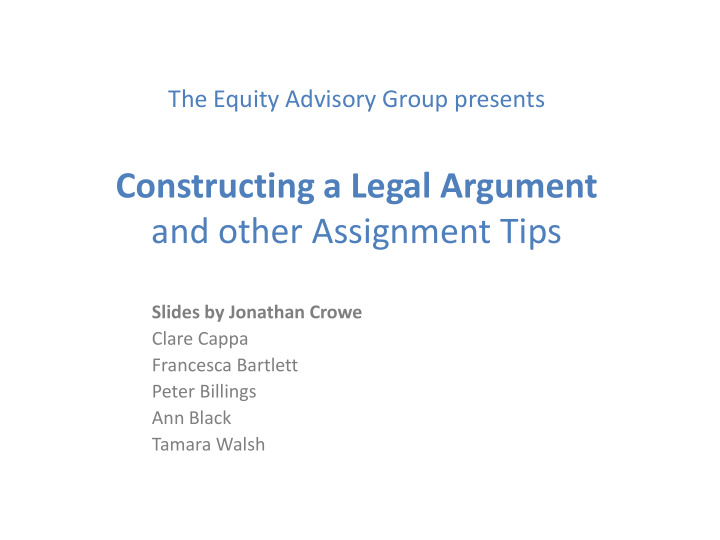



The Equity Advisory Group presents Constructing a Legal Argument and other Assignment Tips Slides by Jonathan Crowe Clare Cappa Francesca Bartlett Peter Billings Ann Black Tamara Walsh
Assignment Tip 1: Good writing • You cannot write an effective legal essay in poor English. Clumsy or unclear expression will spoil your arguments, insights and explanations. – Take as much care with your spelling, punctuation and grammar as you do with the content of your essay. • Good writing has many levels. In order to write well, you need to choose your words with care and write correct sentences in well constructed paragraphs. – You should also take care that the overall structure of your essay is clear and logical. • You should get into the habit of carefully proof reading your essays. It also helps to get at least one other person to read your work. – Help is available for those of you who have difficulty with your writing. If you have concerns, ask your lecturer.
Assignment Tip 2: Good arguments • Good legal writing and advocacy depends on presenting a well structured argument. – This applies whether you are writing an essay, arguing before a judge, advising a client, conducting negotiations or offering a legal opinion. • A good legal argument must be carefully organised and effectively presented. – Prepare carefully. Consider what point you want to get across before you start writing. – Give reasons. Do not simply summarise the views of others or offer unsupported opinions. – Aim for clarity and precision. Focus on getting your point across in an economical fashion.
How an argument works • It is useful to consider exactly how a logical argument fits together. • A logical argument has two parts: the premises and the conclusion. – The conclusion is what you are arguing for (e.g., ‘This case had a negative impact on constitutional government in Australia.’) Be clear on your conclusion before you start writing. – The premises give reasons for accepting the conclusion. In a sound logical argument, it is impossible to accept the premises without also accepting the conclusion.
How an argument works (cont.) • Here is a famous example of a sound argument. Socrates is a person. (Premise 1) All people are mortal. (Premise 2) Therefo fore, re, So Socrate ates s is mortal. tal. (Concl nclusi usion) on) – Notice that it is impossible to accept the premises without also accepting the conclusion. • Legal arguments are usually not this clear cut. But you want to make the connection between the premises and the conclusion as tight as possible. – First, consider the issue carefully. Next, identify what you think is the right conclusion. Then think carefully about the precise reasons that drew you towards that conclusion. These are your premises.
Assignment Tip 3: Clear reasoning • In order to write a good legal argument, you need to make both your conclusion and your premises as clear as possible for the reader. – It is a good idea to make your conclusion clear from the outset. You should state your conclusion in your first few sentences. One way to do this is simply to state: ‘In this essay, I will argue that …’ – Your introduction should also include an outline of your main premises. Having stated your conclusion, you might go on to say: ‘I will give three main reasons in support of this conclusion …’ , then state briefly what they are. – You may have to take some time at the start of your essay to define some key terms. • For example, if you wish to discuss the rule of law, you will have to say what the rule of law is before you can enter into a clear discussion of it.
Other assignment issues • Section headings are often useful to flag the different parts of your argument. – Remember: clarity is your overarching goal. • Format your essay in a way that makes it easy to read and mark. – Most lecturers prefer a standard (not exotic) font such as 12 point Times New Roman. Make sure it is large enough to read easily. – Always use at least 1.5 line spacing. Leave adequate margins.
Other assignment issues (cont.) • The Law School recommends the Australian Guide to Legal Citation. – Some lecturers will accept other citation styles, but the AGLC is the standard. Use footnotes rather than endnotes, unless otherwise instructed. • Check the Course Profile carefully for the word count requirements. – Do not assume you have a 10% leeway. Some lecturers begin deducting marks as soon as you exceed the prescribed length. – Include headings and quotations in the word count. Check whether footnotes are included. • Make sure you follow the Course Profile!
Recommend
More recommend